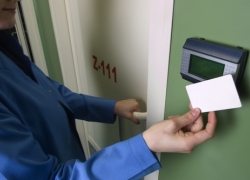Remote airflow and monitoring for your forgotten data closets
Remote airflow and monitoring for your forgotten data closets

Despite the multitude of organizations migrating data into the cloud, certain industries are more likely to keep their IT deployments on-premises. This is especially true in health care facilities, and particularly small to mid-size practices and medical specialists.
As a whole, maintaining these smaller data centers or server rooms is less of a feat than managing a massive cloud or colocation facility. Often, they're no larger than a walk-in closet, tucked away and forgotten in a remote corridor of a shared office space – but that doesn't make them any less mission-critical.
The challenges of cooling a data closet
Smaller data centers face their fair share of maintenance challenges, not the least of which is server-room cooling. According to a report from the Lawrence Berkeley National Laboratory. the vast majority of server rooms were not designed to handle high-maintenance IT equipment. Often, the space was no more than a storage closet or backroom office retrofitted with high-powered servers. As a result, the report noted that cooling conditions in smaller facilities are often "suboptimal."
"Bypass airflow is notorious for hampering small-room cooling efforts."
According to information technology and services expert Paul LaDouceur, bypass airflow is notorious for hampering small-room cooling efforts. This occurs when cool air that is emitted from an A/C unit reaches the return plenum without having passed through any IT equipment. As such, it's essentially a wasted resource. Unfortunately, many small-room operators will attempt to solve this problem by increasing the cooling capacity, only to see energy expenses shoot through the roof with subpar results at best.
For medical practitioners, this type of failure can be particularly problematic. Should an overheating event lead to a server outage, it could bar a health care provider or urgent care center access to critical medical records. Not only is this a violation of the Health Insurance Portability and Accountability Act (HIPAA), but it can also inhibit the staff's ability to provide quality care.

Small rooms need small-room cooling
The above phrasing may sound like an on-the-nose detail, but not all sever room operators are aware of this fact. Furthermore, those who are don't necessarily deploy best-in-class solutions.
In order to efficiently and effectively cool off IT equipment in a smaller facility, operators need a solution that actively evacuates heat from the room, rather than just blasting cool air onto equipment and hoping that warm air finds its way to the return plenum.
This requires placement of an airflow system such as Geist ClosetAir™ near the ceiling plenum return. The vent should be situated behind cabinets, ideally at the end of the room that is opposite from the source of the cool air. With this setup, cool air enters the room and passes through equipment, at which point the residual warm air is drawn into the return plenum with the help of the airflow system.
The beauty of ClosetAir™ in particular is that it relies on sensors to determine the rate of air intake, which means that the cooling system consumes the least possible amount of energy without any intervention from technicians. Furthermore, the easily installable unit doubles as a remote temperature monitor that will alert staff should allowable thresholds be exceeded. This ensures that the equipment stays cool, as do the medical professionals who rely on it to do their jobs.



